Riverdale, NY – Manhattan College and the Brothers of the Christian Schools officially dedicated a 20th century collection of stained glass windows depicting The Life and Work of Saint John Baptist de La Salle on Thursday, April 7.
More about the La Salle Windows here
The Brothers and the College commemorated the completed installation with a Mass in the Chapel of De La Salle and His Brothers at 9:30 a.m., followed by a dedication ceremony at 11:30 a.m., when the Manhattan College Singers performed.

Brother Gustavo Ramírez Barba, FSC, Ed.D., received an honorary doctorate of pedagogy degree at the event.
Brother Gustavo Ramírez Barba, FSC, Ed.D., received an honorary doctorate of pedagogy degree at the event. Br. Gustavo is the General Councilor for Lasallian Higher Education at the Institute of the Brothers of the Christian Schools. He is one of seven General Councilors who “have as their mission to strengthen communion and interdependence in the Institute.” He has served as the executive secretary for the Lasallian Latin American Region and as a regional director for the Mexican and Central American Universities of the International Association of Lasallian Universities.
This campaign to recover the De La Salle windows, spearheaded by Mr. James Casey and Mr. John Hannaway, culminated with the two gentlemen introducing each of the windows as they were unveiled, and telling of its historical context. The ten De La Salle windows and two windows depicting Jesus now have a permanent home in the Chapel of De La Salle and his Brother at Manhattan College.
The procurement, restoration, and installation of the historic treasures portraying significant occasions in the life of Saint John Baptist de La Salle, through the art of Stained Glass, shines a brighter light on the vital patrimony of Our Founder. Their new location in the Chapel of “De La Salle and his Brothers” on the Campus of our venerable Manhattan College, gives a precise and artistic focus on this man who was a pioneer in education. He has given to us the insight that education pertains to the entire person. Education helps the growing human being gain the self appreciation which leads to the full potential of humanity. May this Dedication by Manhattan College, and the District of Eastern North America show to the Church and our Country our belief and dedication to the deeply human necessity of education.
The First St. Joseph’s Normal Institute was built by the Brothers of the Christian Schools at a beautiful location, on the top of a hill overlooking the Hudson River, in the village of Pocantico Hills in Westchester County, New York. This foundation was amply supported by Archbishop Farley, who was the Archbishop of New York in the period between 1902 and 1918. He became a Cardinal in 1911. Farley led a fundraising drive throughout his entire archdiocese, in January and February 1905. Cardinal Farley dedicated the cornerstone of the future building in 1906. The Cardinal was made an Affiliated Member of the Christian Brothers in 1907. He respected the Brothers as Male Religious, but also for the quality of their teaching in the growing number of Parochial schools in the Archdiocese. In so many ways the Brothers made ‘real’ Farley’s desires for his diocese, and the Brothers own desires for the expansion of their mission to provide a Christian Education for all children. The Chapel of that Saint Joseph’s Normal Institute in Pocantico Hills was the first location of these windows. They were transferred to and installed in the Chapel of a new Saint Joseph’s Normal Institute in Barrytown, New York in 1930. The Brothers moved from Pocantico Hills to Barrytown on July 7th, of 1930. The Chapel and the windows were dedicated there by Cardinal Hayes on September 10th, 1930. In his dedication address, Cardinal Hayes, who had succeeded Cardinal Farley, pointed out the windows which so beautifully portrayed the life of Saint John Baptist de La Salle. The windows, having been procured by the Christian Brothers of the District of Eastern North America, and stored in their Archival Collection at Manhattan College, were installed in their third location, which is the College chapel of De La Salle and his Brothers, on April 7th, 2016.
These windows were conceived and fabricated in the studios and workshops of distinguished Masters of the Craft of Stained Glass. These Masters and Artists were a company held in great renown in France – “Mazuet et fils: Bayeux”- in Normandy. This name of the company appears in one of the windows. The work done in this establishment is held in great regard in France up to this day. There are examples of Church windows created by Mazuet and his sons throughout France. In fact as our research grew we found that France is both surprised and pleased that there are Mazuet windows here in the United States.
We have the windows, and we have this third installation. What was the history of these windows before they arrived here in the United States for the first time? In searching for the answers to these questions we owe profound and sincere gratitude to Mr. James Casey whose “radiant determination” has brought us to this installation in Manhattan College. James was a student at St. Joseph’s Normal Institute, Barrytown, New York. He was a Brother for several years. James has given much of his time and his devotion to St. John Baptist de La Salle, as a former Brother, and to understanding and procuring these windows. In an era when many religious houses were closing, the “Unification Church” purchased the buildings in 1974. James visited the empty chapel, and noticed that the windows were still there. Although he had seen them many times, it was only when he began to view these windows through the perceptive eye of a camera, and see the detail revealed through the photographs, James became aware that there was something here of greater value than we may not have seen before. Then began the exciting years of research. James devoted a great amount of energy in finding more and more about the valuable content of the windows. Not only were they wonderful portraits, full of realism, but also classical images and historic frames around the glass. Soon, James was joined by Mr. John Hannaway, also a former Brother. John saw the necessity of professional examination and evaluation of these windows. Through his business contacts, John was able to meet experts in the art of stained glass, and was able to show them the windows. Their evaluations led them to offer their opinion that these windows are of significant art value. John, with James, began a period of important meetings with the Unification Church, regarding the future of the windows. Their meetings were continued by the District of Eastern North America, and Manhattan College joining them in the stages of negotiations toward obtaining the Windows.
Along with those meetings, there began a long period of searching, and finding scraps of information. We often experienced the frustration of being close to some details, but could not locate tangible proof. We tried to answer the questions: “Who ordered these windows?”; “Who actually purchased them, and paid for them?” As much as we combed archives and history books, we could not come up with any verifying information. In our world today we look for records on paper. All we have are four small pieces of paper. Three of them are letters, handwritten on quarter sheets. They are letters written by a Brother Imier of Jesus, who was an important member of the General Council of the Brothers in the early 1900’s. Brother Imier was French but he wrote in fluent English. They are letters to Brother Donatian Joseph, the Brother Visitor of the New York District. The first letter is dated October of 1907, and sent from Paris. Brother Imier wrote that he had been to Bayeux and the Mazuet Studio. There he had seen “parts of the stained glass windows”. There are two letters dated in early 1909, one from Belgium, the other from rue de Sevres, Paris, with some instructions, and then notice of the shipping to America. From another source we know that on June 1st of 1909, Henri Mazuet arrived from France to supervise the installation of the windows. The fourth piece of paper we have is a “Manhattan College Newsletter” of October 1909 which reports: “A group of Students visited Pocantico Hills, the Novitiate of the Brothers. The chapel was specifically interesting by reason of the beautifully (sic) stained-glass windows from the old historic town of Bayeux, which were being put up under the superintendence of the French artist who designed them.”
That is all the documentation we have. BUT we have the windows, and we have a lot of presumed answers to our questions. How come these windows came from France at a time when the Institute in France was in great turmoil on account of the Secular Laws for education? How come they arrived in America when the Institute here was in the middle of “The Latin Question?” Brother Imier, the same French Brother who had written the letters about the windows, had been sent to the United States to assure the Superior General that the American Brothers were “Keeping the Rule!” in the prohibition of teaching Latin. He endeared himself to the American Brothers, and was very pastoral toward them. So! Was this magnificent gift of exemplary art a statement on the part of the French Brothers, that, in France the Institute and its mission will continue? Are they at the same time an encouragement from the Brothers in France, to the American Brothers, to remain faithful to the Institute and to the mission of Education?
James Casey continued his research, even travelling to France and visiting the French Brothers’ National Archives, and many locations which had in them examples of graphics of Saint John Baptist de La Salle. James was informed that from the mid-18th century, when the cause of Sainthood for John Baptist de La Salle was first presented to the Holy See, there was vast activity among the Brothers in France to arrive at the best possible graphic representation of John Baptist de La Salle which was more than a portrait. They tried to present images which would give insight into the person of De La Salle, and the pioneering work that he did for the education of all children, and his founding the Christian Brothers. James was informed that prominent in the development of these representations of De La Salle was a Brother Athanase – his religious name. This Brother was a talented and practicing painter and graphics designer. Many of the paintings done and graphics made were from his brush and stylus. His family name was Alexandre Grellet. He eventually saw the need for himself to care for his elderly father. Alexandre then moved from community to the family home where he continued his work on De La Salle, as a former Brother, and provided many paintings and graphics. It may be honestly presumed that his paintings of De La Salle provided the models for these now ‘our’ windows. In fact, Brother Imier mentions in one of his letters that he would be meeting with a ‘M. Grellet!’ It is acknowledged that the movement for artistic portrayal of De La Salle, which had begun when the cause for Canonization of De La Salle was first presented, reached its apex in the artistry revealed in these windows. John Baptist de La Salle was proclaimed a Saint by Pope Leo XIII in the year 1900.
In the life of Brother Charles Henry entitled “The Gentle American” there is a footnote which gives the information that Pocantico Hills may once have been considered to become the Motherhouse of the Institute, since the Brothers were being ousted from the Paris Motherhouse. The biography asserts that this may account for the many very large rooms there were in St. Joseph’s in Pocantico Hills. This possibility did not take place. Yet there is a wonderment whether the windows were ordered in light of the possibility that the Motherhouse would be re-located in America. As it happened the Motherhouse relocated to Belgium.
About six years ago I was in a Brothers’ community in Sarcelles, a section in northern Paris. There were there three elderly Brothers who at one time had been members of the District of Nantes. Nantes is in Normandy. In Normandy is Bayeux, the location of the Mazuet Studio! Brother Imier had once been the Visitor of that District. These Brothers told me that when Brother Imier found out that the Government would raze the chapel in the Paris Motherhouse, he took out the windows, and had them secretly moved “to another country”! We have no data on that “other country”! Brother Imier’s letters to Brother Donatian Joseph speak about his seeing ‘parts of the windows’ in the Mazuet studios! Are these only suppositions? Usually when there are stories of former years among the Brothers, there is some real incident which may have gone through embellishment in the oral tradition.
Another item can be mentioned here. In the Belgium Motherhouse named ‘Lembeque-lez-Halles’ there were six small windows depicting the life of De La Salle. In the present Motherhouse – which we call today ‘The Generalate’ – in Rome, there are six small windows depicting the life of De La Salle. Were these brought from Belgium to Rome when the Brothers moved there? Were these six windows the ones taken out of the Paris Motherhouse by Brother Imier?
No matter what the truth may be, what the stories are, and what our guesses imagine, we have the Mazuet stained glass windows which come from a significant period in the styles of French Stained Glass Art. We have these glowing windows which pay tribute to the life-work, love of children, and love of God of Saint John Baptist de La Salle, the founder of our Institute of the Brothers of the Christian Schools. They are artistic views of Our Founder, created at the apex of a movement among the Brothers of France to honor De La Salle. We have the history of the Brothers in America, and the years of witness which these windows have given to many Brothers. We have this Installation, which came about through the delicate negotiations of the working committee made up of Brothers and the Administration of Manhattan College. We are deeply grateful to the many who have made contributions and memorials to the movement from Barrytown to the installation here in the Chapel of De La Salle and His Brothers in Manhattan College. In many ways this has also come about through the loyalty, effort and admiration of Former Brothers, grateful Alumni, and our own Brothers. May these works of art, together with our Founder’s writings, and what we Brothers have become through the centuries of our existence encourage, and deepen our conviction that “The need for this Institute is still very great for the Church, the World, children and young people, and all of us.”
by Brother James Loxham, FSC
They let the light shine on us
The day we took the habit and the name of Brother
And thence each early morning they filtered the new sun
Into rainbows over us, half sleeping in the pews,
Novice-groggy lost in the enigma of mental prayer.
Though we rarely thought to raise our eyes to them
They looked always down direct on us. And loved our chants –
From Te Deum’s triumphant on mega feast days to
Ethereal Requiem Aeternam’s for the latest “ancient” in the casket.
Above us, they glowed in multi-colored stains of glass that told
Their tale of Jean Baptist De La Salle, a millionaire who cared about the poor. A man who spent his fortune and his life on a wild dream –
To teach the poor gratuitously. And formed a band of Brothers
To make the wild dream come true. That dream became
The very legacy into which centuries later we as young men
Under the Windows of Barrytown
Would brother.
Today new-homed here in sanctuary at Manhattan College
The Windows of Barrytown come back to life
To tell again their tale in light and rainbow color as a legacy
Now on college campus sharing the tradition of the dream of La Salle.
Honneur à toi glorieux De La Salle
Below the Windows we sing those words again today —
The words that long ago we once young men
Sang as novices in chorus in the Founder’s French
Under the Widows of Barrytown.
We’ve sung them since over half a century and more
Whenever in numbers we would gather
And as if on silent cue, the song would break out of us
In chorus – carousing, reverent, winsome and fond.
Honneur à toi glorieux De La Salle
Apôtre des enfants et gardien de la foi,
Vainqueur de l’ignorance à l’âme si fatale
Honneur à toi, honneur à toi
Look. The Windows are glowing.
It’s their song too.
Mr. Michael Whelan – former Brother, Barrytown class of 1958
Videos from the Event
Illuminations Dedication Ceremony program
Edited video from Illuminations Dedication Ceremony
For more information on the stained glass window collection and their former home at the Brothers’ Novitiate in Barrytown, NY, click here.
For more from Manhattan College, click here.
- The crowd gathers for mass.
- Brothers from the Manhattan College community as well as from around the District attended the event.
- Br. Ed Phelan, FSC, along with others, offer prayers of intercession during mass.
- The De La Salle windows, before they are unveiled.
- Each window has a corresponding plaque, listing the donors that sponsored it.
- A donor wall was erected outside of the Chapel acknowledging all the donors that made it possible to save the De La Salle windows.
- The glass with the names of the original donors for the windows when they were in Barrytown, were also preserved, and act as a piece of illuminated history.
- Br. Jack Curran and Pres. Brennan O’Donnell pose for a photo with Br. Gustavo with his honorary degree.
- Mr. Casey and Mr. Hannaway join Br. Gustavo and Pres. O’Donnell.
- Br. Dennis Malloy opens the dedication ceremony with the invocation.
- Pres. O’Donnell presents and confers the honorary degree upon Br. Gustavo.
- As each window is unveiled, Jim Casey and John Hannaway tell of the window’s history, as audience members followed along in the program.
- Mr. Andrew Ryan, Vice-President for Facilities at the College, supervised the entire process of the windows’ installation…
- …had the honor of unveiling the final window in the series.
- Jim Casey and John Hannaway are congratulated for spearheading the movement to save the DLS windows…
- …and given a small token of appreciation.
- The Most Reverend John Jenik, Aux. Bishop for the Archdiocese of New York blessed each of the windows.
- The Aux. Bishop is assisted by Ms. Lois Harr, Director of Campus Ministry and Social Action, and Asst. Vice-President.
- Br. Raymond Meagher, FSC, of Manhattan College is interviewed by local media.
- Donors, family, and friends pose for photos in front of windows they helped to sponsor.
- For some, sponsoring a window was a family affair.
- Br. Dennis takes a moment after the dedication ceremony for a close, deep look at each of the windows, now in their permanent home.
For more photos from the event, check out Manhattan College’s website



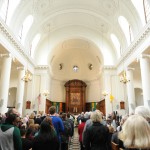
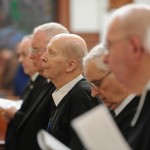
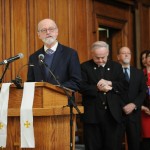
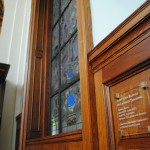
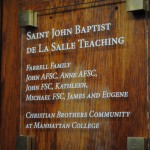
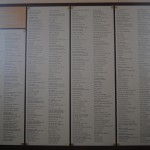
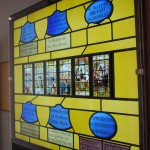
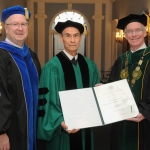
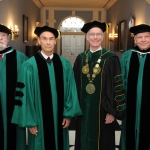
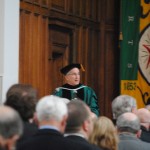
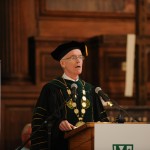
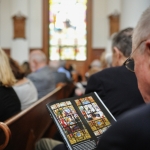
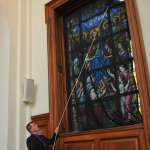
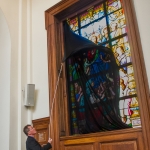
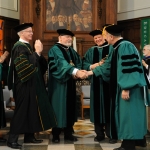
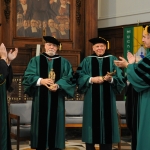
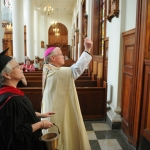
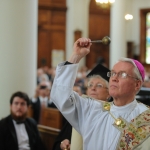
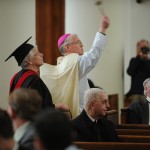
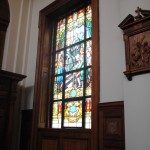
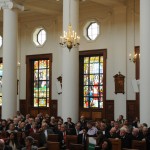
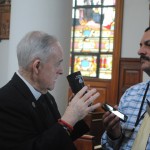
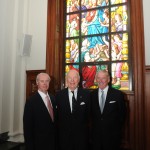
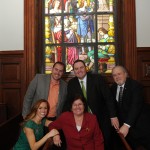
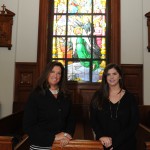
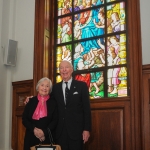
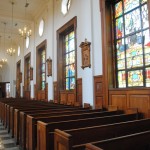
[…] NY – As an extension of the original “Illuminations: The Life and Work of Saint John Baptist de La Salle” initiative, members of the of the 2019 IALU cohort collaborated with the offices of Mission, […]
These windows have given such beauty, meaning, and significance to the College and the LaSallian community that they were meant to be there. So much effort, love and work was done by Mr Jim Casey to secure them that we all owe him an immense ovation of gratitude.
I strongly recommend him to become a benefactor of the Brothers.